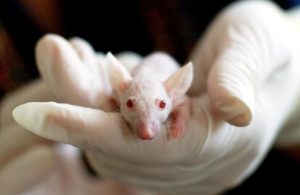 Drug failure rates during Phase I and Phase II are extraordinary. In particular, Phase II (efficacy) has the larges drug failure rate, evidencing the limitation in using lab animal models to predict therapeutic outcomes. Veterinary clinical research may be an alternate pathway for evaluation.
Drug failure rates during Phase I and Phase II are extraordinary. In particular, Phase II (efficacy) has the larges drug failure rate, evidencing the limitation in using lab animal models to predict therapeutic outcomes. Veterinary clinical research may be an alternate pathway for evaluation.
Lab Animal Studies
Lab animal deficits such as low genetic diversity, artificial setting and non-natural diseases are suboptimal for predicting therapeutic outcomes.
Veterinary Clinical Studies
Veterinary clinical research provides pets access to potential life-saving treatments and allows evaluation of new therapies in a real world setting.
 Companion animals develop a variety of diseases that mirror those in people. There is a growing demand by pharmaceutical scientists to evaluate new pharmaceuticals, biologics, devices, and diagnostics in client-owned pets with comparative diseases without having to induce the disease or injury.
Companion animals develop a variety of diseases that mirror those in people. There is a growing demand by pharmaceutical scientists to evaluate new pharmaceuticals, biologics, devices, and diagnostics in client-owned pets with comparative diseases without having to induce the disease or injury.
Comparative Veterinary Medicine
Similarities between humans and dogs
Environment: Companion animals (client-owned) are kept in environments identical to people, with the same exposures and similar lifestyles to their owners.
Diseases and Physiology: Dogs have more similar body weights and metabolic rates to humans than rodents. Like people, companion animals get spontaneous diseases versus induced diseases common in lab animal models. This provides researchers the ability to look at diseases which have the heterogeneity and complexity of naturally occuring diseases found in humans.
Genetics and Immunity: Dogs are genetically more common to humans versus mice, and more genetically diverse versus lab animal genetically restricted models. Induced models, especially in cancer research, are often performed in immunodeficient mice in order to accept the tumor xenograft (avoid rejection). Dogs and cats with spontaneous diseases often have fully intact immune systems like people.
Similarities between human and veterinary medicine
Real World Setting: Veterinary clinical research and medical care has advanced considerably in the last few decades, closing the gap between human care and animal care. In fact, many therapeutics are often evaluated in veterinary clinical settings prior to entering human clinical trials.
Specialists: In addition to receiving a four year doctoral degree in veterinary medicine, many veterinarians choose to specialize by pursuing another 4 years in specialty training. There are various specialties, including surgery, internal medicine, anesthesiology, critical care, pathology, neurology, cardiology, etc.
Diagnostics and Imaging: Many veterinary practices offer a variety of diagnostic and imaging capabilities, including digital radiography, echocardiography, endoscopy, CT, MRI, etc. In addition, veterinarians can employ advanced testing such as flow cytometry, mass spec, and other cutting-edge diagnostic modalities for comparative veterinary clinical research projects.
Proposed benefits of veterinary clinical trials
Veterinary clinical trials may provide several proposed benefits to advancing human and veterinary medicine, and supporting the global One Health Initiative. These benefits may include:
Patient Access: veterinary clinical studies may provide veterinary patients access to new medicines which are not currently available to the general public.
Human and Veterinary Drug Development: veterinary clinical trials may permit a better understanding of the utility of drugs, diagnostics, and medical devices and thereby advance both human and veterinary medicine in parallel.
Reducing Drug Development Costs: because many diseases which occur in veterinary patients are similar to people, the ability to identify better drug candidates through veterinary clinical studies could reduce drug failure rates for human medicine.
Videos Related to Veterinary Comparative Medicine
What veterinarians know that doctors don’t
Shedding Light on Human Diseases
Of Mice, Dogs, and Men
Comparative Diseases (similarities between humans and companion animals)
Oncology
Dogs, like people, can develop a variety of cancers. Some of these cancers have immunophenotypic, histologic, and genetic similarities to humans. Canine cancers, such as lymphoma, osteosarcoma, melanoma, mammary adenocarcinoma, glioblastoma, mastocytoma, and squamous cell carcinoma are naturally occurring cancers in dogs.
Orthopedic
It is estimated that over 20% of dogs will develop orthopedic disabilities, degenerative joint disease, and other musculoskeletal problems. Some comparative orthopedic diseases of dogs are osteoarthritis, meniscal injury, cranial cruciate disease, osteochondrosis dessicans, cartilage injury, and tendon and ligament injuries. Many of these diseases resemble human orthopedic diseases and can be studied using gait analysis systems, MRI, CT, digital radiography, and other modalities.
Dermatologic
Dermatological conditions are very common, and can present similar to human dermatological conditions. Dogs can develop atopic dermatitis and skin allergies which have similar underlying pathology to humans. In addition, dog skin wounds often receive the same treatment as human wounds and naturally occurring dermatological conditions can be useful in studying new drugs and wound care treatments.
Gastrointestinal
Gastrointestingal conditions are very common, and can have similar outward signs and histological features of human counterparts. Dogs and cats can develop inflammatory bowel disease, pancreatitis, steatohepatitis, and a variety of other gastrointestinal disorders which have similar underlying pathology to humans.
Autoimmune
Like people, dogs can develop autoimmune diseases whic have similar immunopathology to human autoimmune diseases. Some more common autoimmune diseases of dogs are systemic lupus erythematosus, pemphigus, myasthenia gravis, autoimmune hemolytic anemia.
Cardiovascular
Dogs can develop a variety of heart related conditions, which can be similar to the human counterpart. In particular, certain cardiovascular diseases such as dilative cardiomyopathy, hypertrophic cardiomyopathy, congestive heart failure, and valvular defects can cause clinical morbidity similar to humans.
Infectious Disease
Like people, dogs are susceptible to a variety of bacterial, viral, and fungal infections which can present similar to human infections. Infections, such as systemic mycosis (coccidioidomycosis, histoplasmosis, blastomycosis), bacterial infections (systemic and localized), and even some viral diseases may be useful for evaluating new pharmaceuticals to benefit pets and people.
Neurological
There is a growing interest, owing to better diagnostics, to study canine neurological diseases and comparative models for human neurological conditions. Dogs can develop Duchenne muscular dystrophy, epilepsy, degenerative myelopathy, spinal cord injury, and degenerative disc disease which can manifest similar to their human counterparts.
Ophthalmology
Ophthalmic conditions of dogs can resemble human ocular diseases, such as keratoconjunctivitis sicca (dry eye), glaucoma, corneal surface diseases, retinal atropy, and cataracts. Keratoconjunctivitis sicca, which is an immune-mediated condition, can resemble human dry eye in immunopathology with reduce tear production. Glaucoma remains the number one cause of blindness in dogs, and often dogs receive shunts and other treatment options just like people.
Veterinary Research Occurring at Institutions
What is an IACUC?
Institutions such as Universities or Contract Research Organizations that conduct veterinary clinical studies may be required to establish an Institutional Care and Use Committee (IACUC). Like an Institutional Review Board (IRB) for human studies, the IACUC is tasked with reviewing and approving protocols, study recruitment plan, study related promotional materials, and informed consent documents related to veterinary and animal studies/trials. The IACUC has a broad scope of oversight and authority and is subject to following regulations as they apply to laboratory animal welfare including studies involving client-owned pets.
The Institutional Animal Care and Use Committee (IACUC) is the committee appointed by an institution which is responsible for the oversight of the animal care and use program. The IACUC should follow the elements veterinary research outlined in the Public Health Service (PHS) Policy on Humane Care and Use of Laboratory Animals (Policy) and the Guide for the Care and Use of Laboratory Animals (Guide). IACUC’s focus on reduction, replacement and refinement of animals used in research and for clinical trials.
Who serves on the IACUC?
The committee must consist of at least five individuals, including a veterinarian trained in laboratory animal care, a scientist with experience in animal research, a non-scientist, and one member who is not affiliated with the institution.
What are the responsibilities of an IACUC?
The IACUC is tasked with the oversight and assessment of animal care and research at an institution. These responsibilities include animal research protocol review, inspection of animal facilities, reports to the Institutional Official, and ensuring the welfare of animals used in research. Humane use of animals and animal welfare is the primary concern and directive of the IACUC. The IACUC is also responsible for monitoring the animal care and use after a protocol has been approved.
Animal Welfare Links

Is an IACUC involved in all veterinary clinical trials?
Not necessarily. Many veterinary clinical trials are performed by private veterinary clinics and not at Universities or contract research institutions. Therefore, many veterinary studies which are not being performed at an institution may not involve an IACUC.